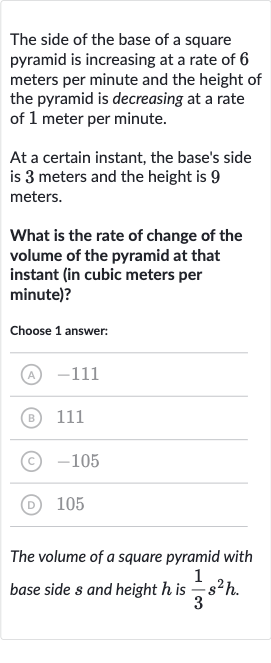AI tutor
Welcome to Bytelearn!
Let’s check out your problem:

The side of the base of a square pyramid is increasing at a rate of meters per minute and the height of the pyramid is decreasing at a rate of meter per minute.At a certain instant, the base's side is meters and the height is meters.What is the rate of change of the volume of the pyramid at that instant (in cubic meters per minute)?Choose answer:(A) (B) (C) (D) The volume of a square pyramid with base side and height is .
Full solution
Q. The side of the base of a square pyramid is increasing at a rate of meters per minute and the height of the pyramid is decreasing at a rate of meter per minute.At a certain instant, the base's side is meters and the height is meters.What is the rate of change of the volume of the pyramid at that instant (in cubic meters per minute)?Choose answer:(A) (B) (C) (D) The volume of a square pyramid with base side and height is .
- Write Formula: First, let's write down the formula for the volume of a square pyramid, which is , where is the side length of the base and is the height.
- Find Derivative: We need to find the rate of change of the volume, so we'll use calculus and take the derivative of the volume with respect to time,
- Apply Values: The derivative of with respect to time is , since we need to apply the product rule to .
- Calculate Result: We know meters per minute (rate of change of the side) and meter per minute (rate of change of the height, it's negative because the height is decreasing).
- Calculate Result: We know meters per minute (rate of change of the side) and meter per minute (rate of change of the height, it's negative because the height is decreasing).Now we plug in the values of , , , and into the derivative. So, .
- Calculate Result: We know meters per minute (rate of change of the side) and meter per minute (rate of change of the height, it's negative because the height is decreasing).Now we plug in the values of , , , and into the derivative. So, .Let's do the math: cubic meters per minute.
More problems from Volume of cubes and rectangular prisms: word problems
QuestionGet tutor help
QuestionGet tutor help
QuestionGet tutor help
QuestionGet tutor help
QuestionGet tutor help
QuestionGet tutor help
QuestionGet tutor help
QuestionGet tutor help
QuestionGet tutor help
